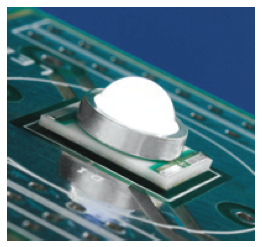 With LEDs only now just beginning to emerge as an important technology for reef aquarium lighting, the hobby’s collective understanding about how LEDs work is still very limited. There appears to be a lot of confusion about the difference between LED wattages since manufacturers don’t exactly list them as such. We recently posted about Coralsky’s newly released products and with the launch of their new forum, Jeffrey Littlejohn decided to kick off a discussion about what it means to underdrive or overdrive a light emitting diode. This write up about LED drive current is a very informative crash course in LED operation 101 and it should answer many questions you may have had about how LEDs actually operate.
With LEDs only now just beginning to emerge as an important technology for reef aquarium lighting, the hobby’s collective understanding about how LEDs work is still very limited. There appears to be a lot of confusion about the difference between LED wattages since manufacturers don’t exactly list them as such. We recently posted about Coralsky’s newly released products and with the launch of their new forum, Jeffrey Littlejohn decided to kick off a discussion about what it means to underdrive or overdrive a light emitting diode. This write up about LED drive current is a very informative crash course in LED operation 101 and it should answer many questions you may have had about how LEDs actually operate.
I have often heard comments about the apparent underutilization of the maximum rated drive current of an LED. Phrases like “underdriving these LEDs at only 350 mA doesn’t allow them to reach their max potential”, or “you need to drive these LEDs at 700 mA or higher to make them useable for coral growth/reef environments”, or “underdriving these LEDs means you have to add more LEDs, which amounts to money wasted” are prevalent around the forums. So, I would like to take this opportunity to clear a few things up.
1. A drive current of 350 mA for a Cree XR-E is not underdriving. This is the nominal/normal/standard drive current for these LEDs. Cree reports the light output of each type of X-Lamp LED at this drive current. So, when you read that a Q5 XR-E puts out 107+ lumens, that intensity is reached at the nominal drive current of 350 mA. While this current may be just a little more than a third of their maximum rated current of 1000 mA, it is the “sweet spot” for Cree LEDs, which means that the LED is operating at its most efficient state, in terms of power consumption and heat generated. To illustrate, if you overdrive an XR-E to 700 mA, you do not get twice the light output from the LED than when it is driven at 350 mA. In fact, it takes nearly 1000 mA to achieve double the light output from 350 mA.
2. For an industry that is trying to push the limits of efficiency (lumens per watt), maximum light output is not the pinnacle achievement. In the example given, it takes about 2.6 times the energy to produce 2 times the light output. If energy efficiency is not one of the reasons that compel you to switch to LED, then you can stick with metal halide.
3. Heat is the bane of LEDs. Cree LEDs must be kept below 150 C at the solder junction. If they get hotter, their lifespan will be adversely affected, or they may fail. Increasing the drive current over 350 mA greatly increases the cooling requirements (it’s not a linear relationship…driving an LED at 700 mA takes more than double the heatsink capacity than an LED driven at 350 mA). Additionally, and apparently this is little known among the self-professed LED “gurus”, a hotter LED produces LESS LIGHT! An overdriven LED, running near its maximum temperature produces only 68%* of the light output! (*For white LEDs. Royal LEDs produce 78% of the light at maximum temperature.) So, to continue with our previous example, let’s assume that the LED driven at 350 mA can be kept under 50 C, and it is producing better than 95% of its rated flux of 107 lumens (let’s say 102 lumens). Now we’ll overdrive it to 1000 mA. Cree says we can expect to achieve about 220% the rated output, but this assumes that the junction temperature remains at a very cool 25 C. From our experience, this is impossible to achieve at this current. Even with very agressive cooling and a large heatsink, you can expect to see junction temperatures of 75-100 C at this current, reducing your 220% expectation to a less compelling 176% increase. If you decide to cut your cooling a little short (heatsinks can be expensive, fans can get dusty or fail), at maximum temperature, you will only achieve 150% of the light output of the nominally driven LED. Now, you’re paying the power company for 2.6 times the energy for only 1.5 times the light! (…and, you’ve spent more money in heatsinks and fans…and, if a fan or two fails, kiss your LEDs goodbye!)
In short, while you could certainly expect more light out of Cree LEDs by overdriving them, if you are not extremely careful with the heatsink design and provide active cooling (fans) as needed, you will end up shortening their useful life or may cause them to fail. Also, especially if you are causing the LEDs to run hotter, you are not getting as much extra light as you may think, and you are certainly not taking full advantage of the efficiency of this technology.
This is not a lecture, it’s a discussion. So let the debate begin!



